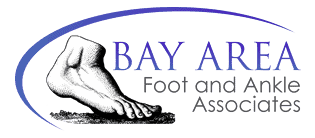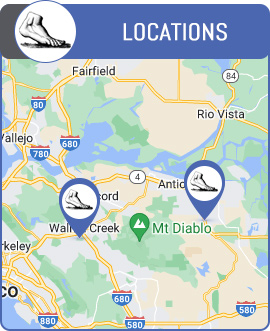Plantar Warts Treatment Specialist in Walnut Creek and Brentwood, CA
Plantar warts treatment offers effective solutions to remove painful warts on the soles of your feet. Our specialists provide safe and targeted care to relieve discomfort and prevent recurrence. If you are experiencing pain and stiffness from plantar warts, come to Bay Area Foot and Ankle Associates for treatment. For more information, contact us or schedule an appointment online! We have convenient locations to serve you in Walnut Creek and Brentwood, CA




Table of Contents:
What is a Plantar Wart?
What causes Plantar Warts?
What happens if a Plantar Wart is Left Untreated?
What is the Difference Between a Plantar Wart or a Corn?
How Can I Tell when a Plantar Wart is Completely Gone?
Our feet connect us to the world in a very literal way; they transport us from place to place and are constantly in contact with a surface, whether it be socks or shoes or the ground. Because our feet contact surfaces more than other parts of the body and are usually in a warm and moist environment, they can be subjected to foreign growths, including warts. Warts that develop on the feet are called plantar warts, which are caused by the human papillomavirus. These growths can be painful and unsightly, and if left untreated, can spread across the feet, causing pain when walking.
Plantar is an anatomical term for the soles of the feet, so plantar warts are small growths that typically appear on the heels or other weight-bearing areas of the feet. The constant pressure placed on the soles of the feet may also cause plantar warts to grow inward beneath a callus, which are hard, thick layers of skin. Most plantar warts are not a serious health concern, however they can persist for months if left untreated. At-home care measures can be effective at removing plantar warts, however professional medical intervention is often recommended when at-home treatments fail to produce results.
Plantar warts are caused by HPV. The virus enters the body through tiny cuts, breaks or other weak spots on the bottom of the feet and, although plantar warts are not highly contagious, they can be transmitted in warm, moist environments, such as showers and locker rooms.
If a plantar wart is left untreated, symptoms can worsen and other areas of the feet can develop similar growths. Symptoms include:
• Hard, thickened skin that forms over an easily definable spot
• Black pinpoints in the middle of growth
• Pain when walking or standing
If left untreated, the aforementioned symptoms can increase in severity and it can be harder to remove plantar warts.
While both corns and plantar warts have a similar appearance and feeling, they can be differentiated by certain characteristics. Plantar warts tend to be small, skin-colored, and rough to the touch, and also look grainy, with small black dots sprinkled around it or within it. They can also appear flat from pressure, depending on which area of the foot is affected. Corns lack a grainy appearance, but instead look like a hard raised bump with dry, flaky skin surrounding it. These variations are due to the different root causes of warts and corns: plantar warts are caused by the human papillomavirus (HPV), whereas corns are caused by excess pressure and friction, similar to how calluses are formed.
Because plantar warts flatten with pressure, it can be hard to tell if they are completely gone. To confirm that a plantar wart is fully removed:
• Visual Examination: Examine the affected foot; a simple visual analysis of the foot should be able to tell if the wart is gone. Look for any black dots, a telltale sign of plantar warts. The skin should also appear smooth, particularly in the ridges of the skin. If the wart is gone, there will be no bump or circle in the line pattern of the foot. In addition, the area may look a little lighter after it has healed, which is a sign that the plantar wart is gone.
• Pain Assessment: Assess if there is still pain when walking or touching the area where the wart was. If the wart is gone, there should be no pain at all.
• Feel The Area: The area should feel smooth and have no bumps.
At Bay Area Foot & Ankle Associates, we care about your health. Our kind and compassionate professionals are experienced in treating plantar warts and can help you improve the health of your soles. Call us today to book an appointment for plantar warts treatment, or visit one of our three clinics: we have one location in Brentwood, CA, and two in Walnut Creek, CA. We look forward to serving you! We serve patients from Walnut Creek CA, Brentwood CA, Pleasant Hill CA, Concord CA, Pittsburg CA, Antioch CA, Alamo CA, Danville CA, and Oakley CA.
How Can I Tell when a Plantar Wart is Completely Gone?
Because plantar warts flatten with pressure, it can be hard to tell if they are completely gone. To confirm that a plantar wart is fully removed:
- Visual Examination: Examine the affected foot; a simple visual analysis of the foot should be able to tell if the wart is gone. Look for any black dots, a telltale sign of plantar warts. The skin should also appear smooth, particularly in the ridges of the skin. If the wart is gone, there will be no bump or circle in the line pattern of the foot. In addition, the area may look a little lighter after it has healed, which is a sign that the plantar wart is gone.
- Pain Assessment: Assess if there is still pain when walking or touching the area where the wart was. If the wart is gone, there should be no pain at all.
- Feel The Area: The area should feel smooth and have no bumps.
At Bay Area Foot & Ankle Associates, we care about your health. Our kind and compassionate professionals are experienced in treating plantar warts and can help you improve the health of your soles. Call us today to book an appointment for plantar warts treatment, or visit one of our three clinics: we have one location in Brentwood, CA, and two in Walnut Creek, CA. We look forward to serving you! We serve patients from Walnut Creek CA, Brentwood CA, Pleasant Hill CA, Concord CA, Pittsburg CA, Antioch CA, Alamo CA, Danville CA, and Oakley CA.

Additional Services You May Need
▸Custom Foot Orthotics
▸Ingrown Toenail Specialist
▸Traditional Podiatry Care
▸Foot and Ankle Surgery Clinic
▸Bunion Doctor
▸Corns and Calluses
▸Foot Arthritis and Joint
▸Warts
▸Video Gait Analysis
▸Athletic Taping
▸Pediatric Foot Specialist
▸Gait Abnormalities
▸Foot Dermatologist
▸Foot Deformities
▸Chronic Foot Injury
▸Diabetic Foot Specialist
▸Acute Foot Injuries
▸Podiatric Sports Services
▸Plantar Fasciitis Specialists


